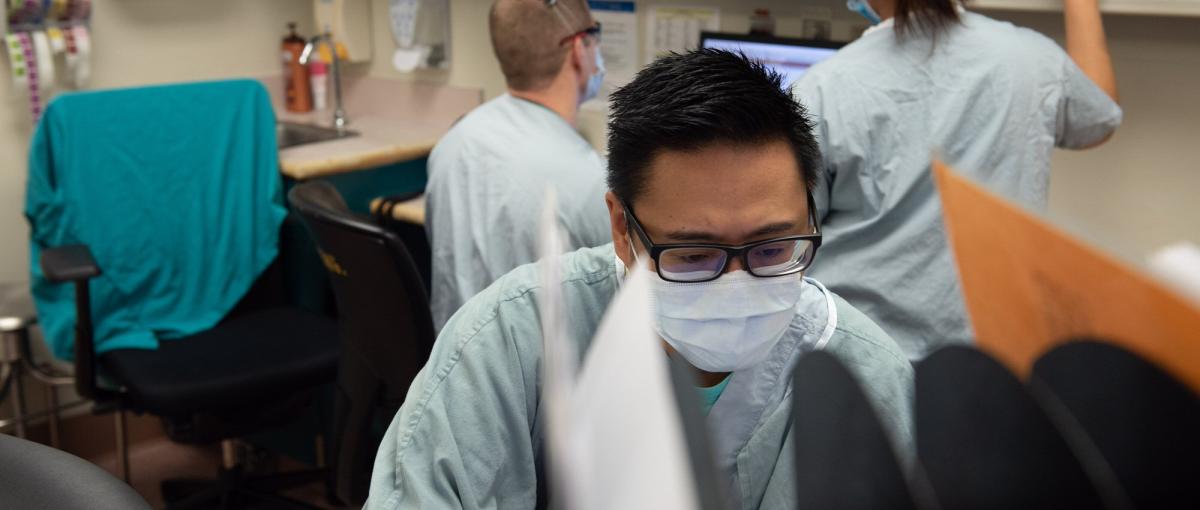Meeting the challenges of COVID
Healthcare teams work together to support patients and each other through the pandemic

September 8, 2020
By Marguerite Watson, Senior Communications Advisor, Covenant Health
At one point during the COVID-19 pandemic, when a patient at the Grey Nuns Community Hospital had a baby, her partner was personally escorted to the cafeteria for meals and all-important cups of coffee.
“It was like a field trip,” says Glenna West, unit manager, labour and delivery. “Spouses and partners couldn't move freely throughout the hospital due to COVID-19 restrictions, so staff rounded them up three times a day and took them to the cafeteria to make sure they were fed.”
That's just one way the women’s health teams at the hospital have risen to the challenges of COVID-19.
Glenna and Ashley Clare, assistant head nurse, labour and delivery, have seen their women’s health teams respond to the challenges of the pandemic quickly while still providing excellent care. And though their patient loads haven’t decreased, staff from different areas — postpartum, labour and delivery and neonatal intensive care — have come together to ensure patient safety.
“People are realizing their capacity and how strong they are,” says Ashley.
Similarly, Dr. Colleen Sweeney, who works in the emergency department at the Misericordia Community Hospital, has seen the difference that collaboration has made to staff’s ability to respond to the pandemic, particularly during the COVID-19 outbreak at the hospital over the summer.
“When the hospital was closed due to the outbreak, we were all very disappointed that our ability to look after patients was disrupted,” says Colleen. “The ER maintained a small number of team members to treat patients who walked in with a life-threatening issue. And any patients who didn't need immediate stabilization were redirected or transferred via EMS to another facility depending on their case. Having great interdisciplinary relations with partners such as EMS was critical, and we couldn’t have succeeded without their support.”
Teams have paid special attention to monitoring updates to government regulations and communicating them to staff and patients to ensure their safety and provide support. While Colleen’s department has used regular emails, online platforms and Zoom and Skype meetings to distribute information and ask and answer questions, Ashley and Glenna’s department has added team huddles to its routine to keep everyone informed.
Teams have also had to be nimble to ensure patients are able to connect with loved ones despite ongoing visitor restrictions. “We‘ve gotten creative in helping patients communicate with their family when visitors aren’t allowed in the hospital,” says Colleen. Staff at both sites have assisted patients with virtual visits using video chat technology.
For Ashley and Glenna’s department, responding to the pandemic has meant changing many of its processes and educating staff about these changes. Clinical nurse educators are running simulations of isolation precautions and practicing with live patient volunteers, and leaders are helping staff practice the principles of donning and doffing personal protective equipment (PPE). Staff are also reaching out by phone to educate patients about process changes and to keep them up-to-date on current visitation guidelines.
Managing the challenges of the pandemic has prompted staff to step outside their box and think critically about solutions, says Ashley. “Staff from all departments are bringing their thoughts to the table.”
For example, when the Grey Nuns was running low on CaviWipes early in the pandemic, housekeeping staff came up with the idea of using another kind of wipes soaked in a high-level disinfectant.
“Without housekeeping coming up with that idea, we wouldn’t have been able to maintain the clean environment that we need,” says Glenna.
Throughout the challenges, staff and physicians have found time to support each other on a personal level. Staying connected has helped people deal with the uncertainty of the pandemic as well as mental and physical fatigue, says Colleen. “There’s a lot of checking in, supporting each other in the stresses of wearing PPE, but also seeing how people's families are doing and realizing the challenges people have at home.”
An outpouring of support from the community has also helped teams get through the difficult times. From offers of free coffee and food at local restaurants to donations of homemade masks to wear after work, the community response has been uplifting, says Ashley.
“I’m proud of all the support and positivity of every single person working in the hospital and out in the community. Everybody stepped up,” she says. “This is a reminder for us to show our kindness and do our best to take care of ourselves and each other.”